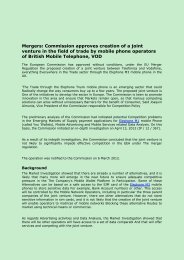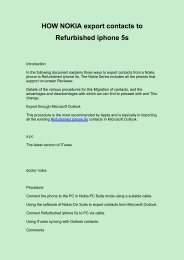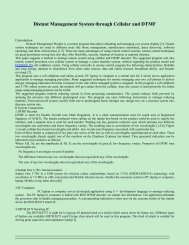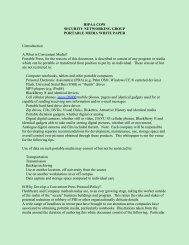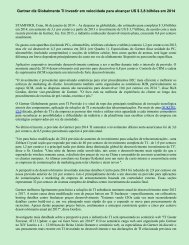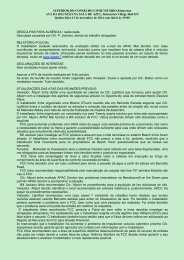o_19m52dmdt158tf5b6o4ks2ava.pdf
You also want an ePaper? Increase the reach of your titles
YUMPU automatically turns print PDFs into web optimized ePapers that Google loves.
Summary of GSM and GSM Security<br />
Abstract<br />
In the past decade mobile emails has become one of the driving forces of the electronic revolution. Everyday, many<br />
individuals are making Lenovo K3 phone calls by pressing a few buttons. Little is known about how one person’s<br />
speech reaches the other person’s cellphone that is a large number of miles away. Even less is known about the<br />
precautionary features and security behind the program. The complexness of the mobile cellphone is increasing as<br />
individuals start texting and electronic pictures to their loved ones. The Lenovo S8 mobile cellphone is gradually<br />
turning into a handheld computer.<br />
All the features and improvements in mobile cellphone technological innovation requires a central source to support it.<br />
The program has to shield you and the capability for growth to accommodate future improvements. Common System<br />
for Mobile Communications, GSM, is one of the many alternatives out there. GSM has been known as the “Wireless<br />
Revolution” and it doesn’t take much to realize why. GSM provides a protected and private method of interaction.<br />
GSM<br />
General System for Mobile Communications, GSM, is a high level mobile telephone program used all over the globe.<br />
GSM has many advantages over its predecessors in terms of security, potential, clarity, and area coverage [8]. GSM is<br />
designed to offer a protected relationship for interaction. Since its advent in the early 1980’s it has grown into a group<br />
of alternatives to offer everything from mobile speech to mobile details interaction [10].<br />
The best way to appreciate security is by looking at how disorderly and dangerous a mobile emails program would be<br />
without security. At any given time, any body could eavesdrop into your discussion. Your bank username and<br />
passwords, routine, and any other details you may disclose on the Lenovo K3 cellphone would be at risk. Besides<br />
listening in, at any given time, a hacker could impersonate your customer details to contact individuals that would later<br />
amount to lots of money in support charges. The list goes on and on. GSM was designed to deal with security issues<br />
like those detailed above.<br />
HISTORY<br />
GSM was initially designed in Europe as a replacement for their existing pan-European Cellular telephone program.<br />
A panel was formed in 1982 to create a roaming program that provides potential and comfort [5]. By 1987, eighteen<br />
nations created responsibilities to implement mobile techniques depending on GSM. Four years later, commercial<br />
techniques were in position. GSM is now created up of over 745.5 thousand members in 184 countries [4]. The GSM<br />
close relatives is now consisting of EDGE, 3GSM, and GPSR [9].<br />
BENEFITS<br />
GSM was designed to grow and meet the needs of new technologies. GSM is currently consisting of EDGE, 3GSM,<br />
and GPSR. Each friend is designed to fix a particular need. EDGE is an in the component used for innovative mobile<br />
alternatives such as downloading music segments, videos, and multi-media information. GPSR is designed for<br />
“always-on” techniques that are required for web-browsing. 3GSM is the GSM running on third creation requirements<br />
for multi-media alternatives [9].<br />
In addition to growing, GSM was designed with security in mind. Older mobile techniques were analog centered and<br />
therefore very vulnerable to security attacks. It was common for assailants to eavesdrop and indentify people’s<br />
discussions and details. Even worse yet, assailants were able of stealing customer IDs to create fake phone calls.<br />
Eavesdropping allowed assailants to listen in on a individual discussion. One specific case engaged the British Royal<br />
close relatives and Princess Di, where an enemy was able to indentify a line of interaction and launch the discussion to<br />
the media [4]. GSM also beats out its competition by offering verification, protected bandwith, and customer<br />
bandwith.<br />
COMPONENTS<br />
The GSM facilities is consisting of a mobile position, a platform transceiver position, and a mobile changing middle.<br />
Each piece is vital to the whole details return process.<br />
Figure 1 Elements of GSM [4]
Mobile Station<br />
In the broadest sense, the mobile position is any program able of containing a customer recognition module<br />
(SIM). The product is usually a mobile cellphone. The mobile cellphone consists of a SIM and an Worldwide Mobile<br />
Devices Identity (IMEI). The SIM program stores delicate details such as individual contacts, the Worldwide Mobile<br />
Subscriber Identity (IMSI), a individual recognition variety (PIN), and a key key, Ki, for verification [4]. The PIN<br />
allows the customer to create changes on the SIM program.<br />
Base Transceiver Station<br />
The platform position is accountable for offering the weblink between the mobile cellphone and the changing<br />
middle. When a contact is initially created, it travels to the changing position via the hundreds of platform channels.<br />
The channels are accountable for carrying and converting the speech alerts [4].<br />
Mobile Switching Center<br />
The changing middle connects Lenovo S8 mobile phones to mobile phones. The platform transceiver channels<br />
communicate with the changing position to weblink mobile mobile phones together. The changing position is the hub<br />
of the whole program. The mobile middle is accountable for verification, details changing, position upgrading, and<br />
redirecting [4].<br />
SECURITY<br />
The two security goals of GSM are to offer an facilities which protects access to the mobile alternatives and to avoid<br />
any details from being revealed. In other words, GSM is designed to avoid fake cellphone use and to offer comfort for<br />
both events. The following precautionary features are done to shield you [4]:<br />
Authentication for regitered users<br />
Secure Data Transfer<br />
Subscriber Identity protection<br />
Lenovo K3 mobile phones are inoperable without SIM chip<br />
Duplicate SIMS on program are not permitted<br />
Keys are securely stored<br />
If all the actions detailed above are met, GSM will be able to offer comfort, verification, comfort, and reliability [1].<br />
GSM divides security on three different levels. Each stage provides the procedure for comfort, verification, comfort, or<br />
reliability. On the minimum stage of security, GSM provides verification and comfort for the customer through the<br />
SIM card. The SIM processor serves as the recognition of the customer. Payments and verification are verified<br />
through the SIM processor. The second part of security recognizes the position of the customer and reveals the<br />
inbound callers name to the recipient so the recipient can choose whether or not to accept the contact. The third part<br />
encrypts any details traveling between the two customers. With the details secured and relationship protected,<br />
reliability and comfort is offered [2].<br />
ENCRYPTION IMPLEMENTATION<br />
A mobile contact placed on a GSM program goes through two steps. Any Lenovo S8 cellphone must first be<br />
authenticated before any details transmitting can start. Following effective verification, a individual key, Kc, is<br />
produced for details return.<br />
Authentication is done through a challenge and response procedure. The platform position initially delivers out a<br />
unique 128-bit variety, r, to the mobile cellphone [1]. Using A3 security, with information Ki from the SIM and the<br />
unique variety r, a 32-bit secured variety SRES is produced [1]. The mobile cellphone then delivers the SRES<br />
produced variety back to the program for validation. The program itself knows the mobile device’s Ki and can thus<br />
compare the value it produced to the value the mobile cellphone produced. Authentication is effective if both numbers<br />
are identical [7].<br />
Figure 2 Initial Authentication Between User & Network<br />
If verification is effective, a relationship is created and a new key, Kc, is produced to be shared by the customer and<br />
program. The key is produced by implementing an A8 criteria on values Ki and the unique value r. By doing this, a
individual key Kc will be produced for later use when shifting details [1].<br />
Figure 3 A8 Key generation<br />
With a individual key Kc produced, details can be exchanged between two events. GSM speech ciphers by using the<br />
A5 criteria with information Kc, which is known by both events, and the inbound details [1]. At that point details<br />
security and decryption is completed.<br />
Figure 4 Data encyprtion and decryption<br />
SECURITY ISSUES<br />
GSM provides many layers of security. A lot of the security goes on behind the scenes with the customer knowing<br />
very little about what is secure and what isn’t secure. Despite the security improvements with GSM, there still exist<br />
many security pitfalls. As the GSM close relatives grows more complex, more security issues arise.<br />
Security Isssues Solved<br />
SIM processor and PIN<br />
One means of security that GSM provides is obtained through the use of a PIN. The PIN stops unauthorized customers<br />
from changing details on another consideration. The PIN also stops fake use of a cellphone if it is thieved. GSM<br />
specifically stops more than one SIM processor from being on the program simultaneously. By doing this, a customer<br />
who is able to impersonate and replicated a SIM processor will still have troubles getting on to the program because<br />
the original owner of the SIM may still be on the program [5].<br />
Security Issue Problems<br />
COMP 128<br />
At when, a lot of GSM Lenovo K3 phones apply a COMP 128 criteria within of the A3 and A8 security schemes. The<br />
COMP 128 criteria has a weak point which allows an enemy to retrieve the key key Ki from the mobile device’s SIM<br />
processor [6]. This is obtained by delivering known details to the mobile cellphone and examining the results that are<br />
returned from the program. With this knowledge, the enemy can replicated the SIM processor for fake use. It is<br />
approximated that a enthusiast could purchase the necessary equipment to “clone” SIM snacks for less tan $40,000 [6].<br />
The COMP 128 criteria became a community concern after IBM researchers demonstrated that they had discovered<br />
away to replicated a SIM processor with in a few seconds [6]. Efforts have been created to create new methods to<br />
correct this issue.<br />
A5 Execution and Eavesdropping<br />
The A5 criteria used to encrypt streaming cipher details is not a universal standard. There are currently three<br />
implementations, A0 /0, A5/1, and A5/2. All of them are used across the globe, varying from area to area. A5/1 is the<br />
strongest security because it has a brief time complexness of 2^54. A5/2 has a brief time complexness of only 2^16<br />
[4]. The sluggish A5 implementations are vulnerable to eavesdropping.<br />
Lack of Testing<br />
The methods used for GSM are all invisible from the community [4]. At first glance this may seem reasonable but<br />
being invisible from the community eye stops it from being tested by the globe. As more and more individuals start<br />
finding weaknesses about the program and the methods, more individuals will start hacking the techniques. When this<br />
does happen it will be difficult to fix the issue when the issue has already spread to thousand and an incredible number<br />
of Lenovo S8 phones. If the methods were free, then more examining could be done before the mobile phones were<br />
all distributed to the community.<br />
Lack of Internal Encryption<br />
GSM fixed most of the security issues engaged with transmitting of details through the radio channel. Currently<br />
details is only secured between the Lenovo K3 cellphone and the platform channels. All other interaction and<br />
signaling on the set telecoms program is done in plain written text [4].
Short Concept Service<br />
Short message support (SMS) is a support offered through GSM that allows customers to deliver sms information<br />
to other mobile customers. Users often overlook the fact that SMS provides no actual security [4]. All information<br />
sent via SMS are sent in a predictable, clear written text format. The originating deal with of a SMS message can be<br />
made. This weak point allows anybody the ability to deliver information to mobile phones with harmful instructions<br />
[6]. People could be instructed to deliver delicate details back to the emailer. The emailer would then be in position to<br />
record the details.<br />
Physical Theft<br />
GSM packs all the details required to use in a cellphone within a single SIM processor. By doing that, the value of the<br />
cellphone itself has increased. A new cellphone can be used by replacing the SIM processor. No actual actions can be<br />
taken against actual cellphone robbery.<br />
Solutions to Present Security Issues<br />
A fixed edition of the COMP 128 has been designed, however, the cost to replace all SIM snacks and consist of the<br />
new criteria is too costly to Lenovo S8 cellphone organizations. The new launch of 3GSM will consist of a stronger<br />
edition of the COMP 128 criteria and a new A5 criteria implementation. The A5/3 is predicted to fix current comfort<br />
and reliability issues [4]. Fixed program transmitting could be set by simply implementing some type of security to<br />
any details transferred on the set program.<br />
Conclusion<br />
GSM has many advantages over current mobile techniques. The issue now involves the COMP 128 criteria issue.<br />
This issue will be fixed as newer technological innovation gets phased in. The deficiency of extra security on the<br />
telecoms program doesn’t pose as a significant issue because any bandwith on there will have the same security as the<br />
present community switched telephone. Despite the present issues more and more mobile organizations will switch to<br />
GSM centered requirements. An approximated one billion members are required by the end of 2003. As GSM<br />
gradually moves towards 3GSM, more issues and security issues will be settled.



